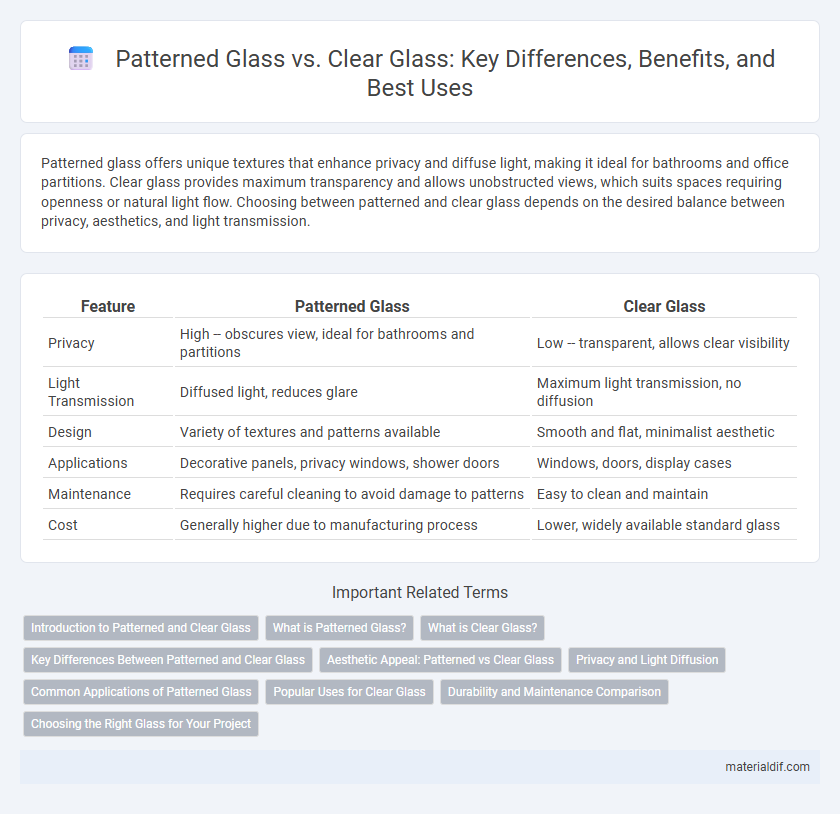Patterned glass offers unique textures that enhance privacy and diffuse light, making it ideal for bathrooms and office partitions. Clear glass provides maximum transparency and allows unobstructed views, which suits spaces requiring openness or natural light flow. Choosing between patterned and clear glass depends on the desired balance between privacy, aesthetics, and light transmission.
Table of Comparison
| Feature | Patterned Glass | Clear Glass |
|---|---|---|
| Privacy | High -- obscures view, ideal for bathrooms and partitions | Low -- transparent, allows clear visibility |
| Light Transmission | Diffused light, reduces glare | Maximum light transmission, no diffusion |
| Design | Variety of textures and patterns available | Smooth and flat, minimalist aesthetic |
| Applications | Decorative panels, privacy windows, shower doors | Windows, doors, display cases |
| Maintenance | Requires careful cleaning to avoid damage to patterns | Easy to clean and maintain |
| Cost | Generally higher due to manufacturing process | Lower, widely available standard glass |
Introduction to Patterned and Clear Glass
Patterned glass features textured designs that provide privacy while allowing light transmission, making it ideal for decorative and functional applications in offices and bathrooms. Clear glass offers maximum transparency and clarity, commonly used in windows and display cases where unobstructed views are essential. Both types serve distinct purposes, balancing aesthetics, privacy, and light diffusion in architectural and interior design.
What is Patterned Glass?
Patterned glass features textured or embossed designs on its surface, created during manufacturing to provide privacy while allowing light to pass through. Unlike clear glass, which is smooth and completely transparent, patterned glass diffuses light and obscures visibility, making it ideal for bathroom windows, office partitions, and decorative applications. Its varied patterns enhance aesthetic appeal and can also improve safety by reducing glare and fingerprints.
What is Clear Glass?
Clear glass is a transparent material primarily composed of silica, soda ash, and limestone, offering high optical clarity and minimal distortion. It allows maximum light transmission, making it ideal for applications requiring unobstructed views or natural lighting, such as windows and display cases. Unlike patterned glass, clear glass lacks surface textures, ensuring a smooth and even appearance.
Key Differences Between Patterned and Clear Glass
Patterned glass features textured surfaces that obscure visibility while allowing light to pass through, making it ideal for privacy applications in bathrooms and office partitions. Clear glass provides transparent, unobstructed views, maximizing natural light and visual connection between spaces. The key differences lie in their light diffusion properties, privacy levels, and aesthetic impact, with patterned glass offering decorative versatility and clear glass emphasizing clarity and openness.
Aesthetic Appeal: Patterned vs Clear Glass
Patterned glass enhances aesthetic appeal by offering unique textures and designs that create visual interest and diffuse light for privacy without sacrificing brightness. Clear glass provides a sleek, minimalistic look with maximum transparency, ideal for open spaces that prioritize natural light and unobstructed views. Choosing between patterned and clear glass depends on whether the design goal emphasizes decorative elements or clarity and openness.
Privacy and Light Diffusion
Patterned glass enhances privacy by obscuring visibility while still allowing natural light to penetrate, making it ideal for bathrooms and office partitions. Clear glass offers maximum transparency and light transmission but lacks privacy, making it less suitable for spaces requiring discretion. The textured surface of patterned glass diffuses light effectively, reducing glare and creating a softer, more even illumination compared to clear glass.
Common Applications of Patterned Glass
Patterned glass is widely used in office partitions, shower enclosures, and decorative windows due to its ability to provide privacy while allowing light transmission. Its textured surface diffuses light, making it ideal for bathroom windows, cabinetry, and glass doors where obscured visibility is desired. Unlike clear glass, patterned glass enhances aesthetics and functionality by combining translucence with design elements.
Popular Uses for Clear Glass
Clear glass is extensively used in residential and commercial windows, allowing maximum natural light transmission and unobstructed views. It is also preferred for glass tabletops, display cases, and picture frames due to its transparency and versatility. In automotive manufacturing, clear glass is standard for windshields and side windows, ensuring driver visibility and safety.
Durability and Maintenance Comparison
Patterned glass offers enhanced durability due to its textured surface, which is less prone to visible scratches and fingerprints compared to clear glass. Its design helps hide dirt and smudges, reducing the frequency of cleaning and maintenance required. Clear glass, while offering superior transparency, demands more frequent cleaning to maintain its pristine appearance and is more susceptible to scratches and wear over time.
Choosing the Right Glass for Your Project
Patterned glass offers privacy and decorative elements, making it ideal for bathrooms, offices, and partitions where obscured vision is desired, while clear glass provides maximum transparency and natural light, suitable for windows, storefronts, and display cases. Selecting the right glass depends on the balance between aesthetic appeal, functionality, and privacy requirements specific to your project. Consider factors like light diffusion, maintenance needs, and safety standards to ensure optimal performance and design harmony.
Patterned glass vs Clear glass Infographic

 materialdif.com
materialdif.com